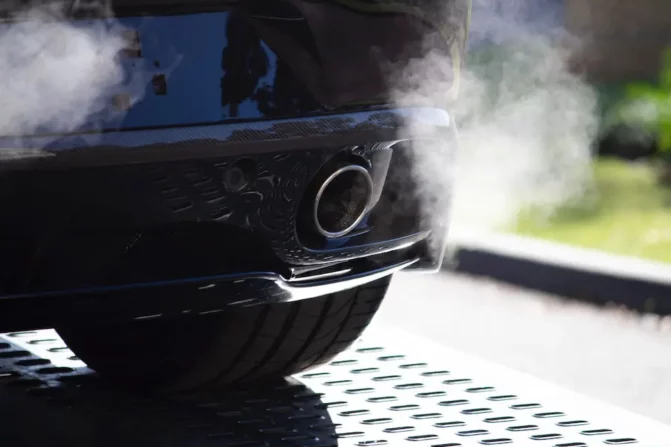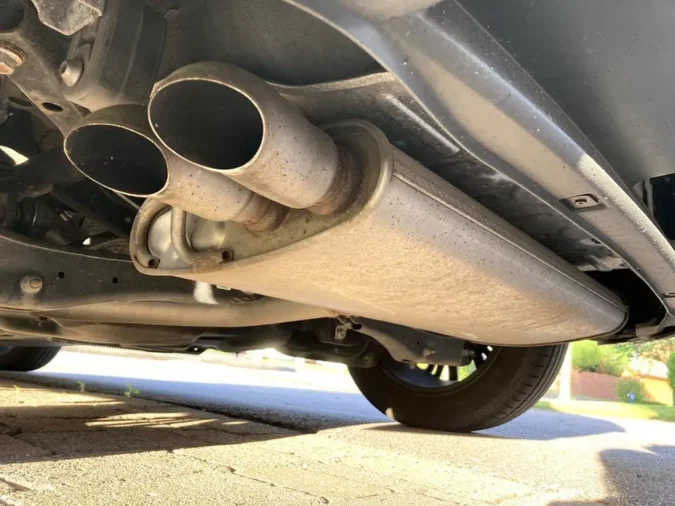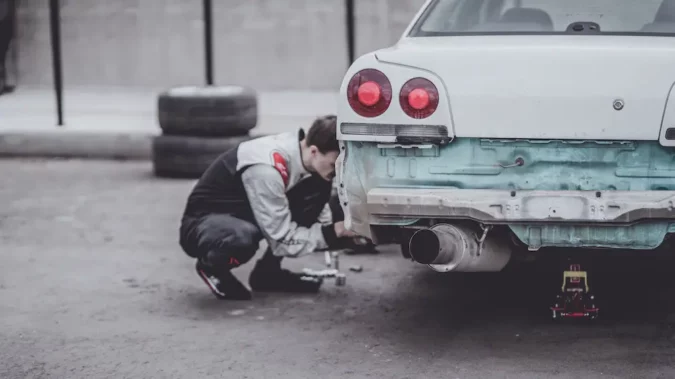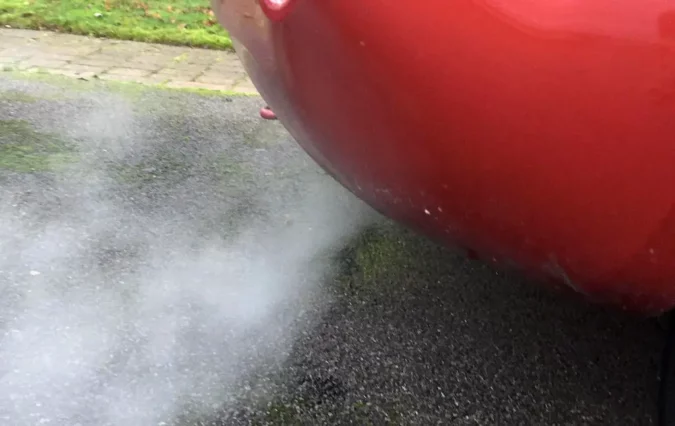Blue smoke from exhaust on startup is absolutely not a good sign. Any other color of smoke than thin white or something very light that resembles water vapor (i.e. there’s water coming out of the exhaust, or if there’s water coming out of the exhaust while idling) coming from a car’s exhaust is a clue that there is a problem.
This issue, directly tied to the engine’s combustion system, could be harmful if it is not resolved immediately. In the meantime, let’s investigate the potential causes of blue smoke coming from a car’s exhaust and the best method to resolve the situation before it worsens.
To understand why your automobile is smoking and why the smoke is the color it is, you must first understand the fundamentals of how a car operates. Then, and only then, will we be able to identify the problem.
- What is White Smoke?
- What is Blue Smoke?
- What is Black Smoke?
- What is Grey Smoke?
- Causes of Blue Smoke?
- How to Fix it?
- Stop Blue Smoke Additives
- FAQs
White Smoke From Exhaust
Numerous reasons might cause white smoke to come from the exhaust, but one of the most frequent issues is when the engine is operating at a higher temperature than typical. When you start the automobile, a little white smoke may come out when the engine warms up and expels humidity. But excessive smoke coming out of your exhaust may indicate a few issues with the car.
White smoke may be a sign of an overheating engine or a problem with the cooling system. Such as a leaky intake manifold or head gasket that is affecting the coolant. It’s best to schedule a service appointment as soon as you see it because these issues could become significant, engine-wrecking issues if not addressed.
Blue Smoke From Exhaust
When the proper parts aren’t treated at service, blue smoke—which is frequently mistaken for white smoke and can signal an oil problem—can develop into worse issues later. Despite being frequently referred to as “blue” smoke, it is usually more of a purple-grey or extremely light blue.
This smoke frequently occurs together with a general lack of power or difficulty accelerating the vehicle. This is unquestionably the case with turbocharged vehicles, as blue smoke can also indicate a problem with the turbocharger. For more insight on the latter, you can check out our write-ups on supercharger vs turbocharger, and what a P0299 code means.
Blue smoke coming from an ordinary gas-powered car’s exhaust usually indicates that your car is burning oil. However, there are other possible explanations as well. Smoke could be coming from the exhaust due to an oil leak that allows oil to enter areas of the engine that it shouldn’t.
If you notice blue smoke coming from your exhaust, you should stop and call your roadside assistance company if you have one. If you continue to drive, you not only put other road users in danger. But any oil leaks could also cause a fire in your engine bay.
Black Smoke From Exhaust
The presence of black smoke in the exhaust indicates a problem with the fuel, which may be polluted or excessively combined with the air in the engine (air and fuel are supposed to mix but in the proper proportions – in this case, your car engine is running too rich, where there’s too much fuel). It shouldn’t be a major issue if there is only a brief burst of smoke that then goes away.
But it’s probably worth discussing with your service advisor at your subsequent servicing. A bigger issue exists if your exhaust produces excessive amounts of black smoke. It’s possible that the sensors, injection system, or fuel line are malfunctioning, necessitating a trip to the workshop to fix each one.
Leaving the issue unattended could result in you using more gasoline than usual. As well as posing a danger to other drivers and possibly rendering your vehicle unroadworthy. Similar to blue smoke, it is recommended to avoid driving while it is present because any fluids escaping the gasoline line may be flammable.
Grey Smoke From Exhaust
Grey smoke from exhaust is less frequent, making it more difficult to determine its precise cause. It could result from the burning of extra engine oil or a turbocharger that is malfunctioning or broken. There is a good likelihood that oil has gotten into the airflow and then into the cylinders.
Where it burns if the problem is a defective turbocharger. If the feed is the issue, it can be easily fixed; however, if the turbocharger itself is broken, it may need to be rebuilt or replaced. Other potential factors might be:
1. Worn Positive Crankcase Ventilation (PCV) Valve:
This might also cause grey smoke from exhaust since it is supposed to keep back unburned gasoline from the engine, and if it fails to do so, more smoke will come out of the exhaust. This is a straightforward diagnosis and fixes for any skilled technician compared to some other issues.
Therefore, it’s worth diagnosing the PCV valve for issues, such as spotting the symptoms of a bad PCV valve. Or, needing to consider a PCV valve replacement.
2. A Leaking Valve Stem Seal:
This part’s job is to prevent combustion chamber oil from leaking into the cylinder head. A problem between the valve and the valve guide causes the valve seals to fail (in the cylinder head). When everything comes free, there is enough room for the valve to rock horizontally, which affects the seal.
Then, it will need to be replaced or rebuilt, which could be an expensive fix. When you accelerate while halted at a stop sign or after a brief stop. It’s possible for the car to emit blue- or light-gray exhaust smoke before clearing up.
This is an obvious indicator of a valve guide seal issue. These typical symptoms of bad valve seals are an indicator that you need to consider the valve seals replacement cost.
3. Failed/Loose Piston Rings:
These can also cause grey smoke from exhaust during severe acceleration, but this is uncommon. Otherwise, you’ll have to account for the cost of replacement piston rings.
4. Transmission Fluid Leak:
If you have an automatic vehicle, smoke could indicate that transmission fluid is entering the engine due to a leak somewhere. You will need to take your automobile to a mechanic to find the leak and perform the required repairs or replacements.
Once you’ve figured out how to check the transmission fluid (as well as when to check transmission fluid), it’s worth looking for the symptoms of low transmission fluid. Then, if you’ve found a transmission fluid leak or a transmission seal leak, take into account the transmission leak repair costs.
Blue Smoke Diesel
Your car is a cohesive unit composed of numerous pieces that operate together. We just consider the main factors that frequently contribute to this issue.
Blue Smoke From Exhaust On Startup Causes #1: Oil In The Combustion Chamber
A leak of fluid inside the combustion chamber is one of the most frequent reasons for the issue of white-to-blue automobile smoke. The fluid will typically circulate in places that are completely different from where fuel and air mix before coming into contact with a heat source.
The lubricating liquid will gradually pass through the gaps or cracks and into the combustion chamber if the piston rings, valve seals, and other holding mechanisms fail for whatever reason. Such as not receiving the required maintenance or if these components are too old.
This leak causes damage deep inside the engine as well as a coating of blue smoke that is visible to the human eye. If lubricating oil enters the combustion chamber and the car loses a substantial amount of oil, the oxygen sensor will be harmed.
Blue Smoke From Exhaust On Startup Causes #2: A Damaged Turbocharger
Your engine receives a perceptible performance boost due to the engine turbocharger. But this component is also the reason why the car emits blue smoke. Because while the turbocharger is running, it uses highly compressed air, and if this air flow does not travel as it should.
The damage will result, and a very significant hole will result. When fuel is burned, there is a risk that coolant or engine fluid will leak into the engine, causing blue smoke to emerge from the exhaust.
Blue Smoke From Exhaust On Startup Causes #3: A Shattered Piston Ring
Manufacturers have employed thin piston rings to isolate liquids like engine oil from other engine components and eliminate the danger of even a small amount of liquid leaking. However, these piston rings have a lifetime just like every other feature.
The service life of this metal component will be significantly decreased under unfavorable operating circumstances or if the required maintenance is not performed. The ring cannot prevent the oil from leaking back into other components when the damage has spread too far. Additionally, blue smoke will develop when the engine oil and fuel are combined.
Blue Smoke From Exhaust On Startup Causes #4: A Clogged PCV Valve
The oil that seeps straight into the fuel or fuel compartment will produce blue smoke and have negative effects down the road if it enters the combustion chamber or other combustion processes, which is already a bad thing. But how does fluid manage to enter the fuel line and tank? The following are some of the primary causes of this.
- PCV valves, piston rings, and valve seals can no longer perform as intended. Leakage from valve seals or rings will depend on where the component is damaged.
- The PCV valve forces all of this gas into the intake manifold and into the combustion chamber. Where it is re-ignited by sucking out any remaining air in the crankcase using the engine’s vacuum.
- If the PCV valve becomes blocked due to excessive deterioration. Blue smoke will emanate from the exhaust when the fluid combines with the fuel, air, and other gasses.
Blue Smoke From Exhaust On Startup Causes #5: Engine Oil Leaking
The oil will evaporate as soon as it becomes too hot, much like many other liquids do. If this oil unexpectedly escapes during transport and lands on any area of the operating engine. Where the surface temperature can reach hundreds of degrees, the evaporation reaction will happen right away. The blue smoke is produced as a result of this procedure.
Blue Smoke From Exhaust On Startup – How To Fix
Here are some tips on fixing this issue:
Blue Smoke From Exhaust On Startup Solution # 1. Drain Extra Oil
Oil problems are one of the reasons why blue smoke from cars appears. Therefore, altering the amount of oil in the car is the fastest option to address this problem. To prevent damaging the PCV or crankcase breather with excessive pressure or increasing the chance of leaks, you must first remove any extra oil. More excess oil increases the likelihood of aeration and pressure increase.
If too much oil is added, it won’t have enough room to circulate. The surplus oil mixes with the air when the shaft spins during engine operation, causing aeration. Air bubbles in the oil will diminish its ability to lubricate, which will increase heating in the machine. The parts of the engine will eventually suffer damage.
A lot of oil can also raise the pressure inside the engine and eventually cause seals and rings to leak. If one or more of them fails, there will be leaks and expensive repairs required. It is more difficult for the engine to handle heat and friction better when these two things happen together.
To solve this problem, simply drain the surplus oil and leave only the essential amount in place. Furthermore, getting rid of surplus oil might help get rid of old fluid that no longer properly protects components from friction.
Blue Smoke From Exhaust On Startup Solution # 2. Maintain The Engine
Engines gradually deteriorate without normal cleaning and maintenance, eventually developing leaks and producing blue smoke. Regular maintenance in general, and engine cleaning in particular, will greatly reduce or even eliminate this problem.
Blue Smoke From Exhaust On Startup Solution # 3. Change Damaged Piston Rings
If the piston rings are worn, the engine’s lubricating oil will leak into the combustion chamber and burn, lowering engine performance and producing blue smoke in the exhaust. As a result, piston rings ensure that joints are sealed, stop oil leakage, and have a number of other benefits. Therefore, it’s crucial to check, take off, and replace any damaged rings with new ones.
Blue Smoke From Exhaust On Startup Solution # 4. Install A New PCV Valve
A jammed or clogged PCV valve, which is an essential part of the exhaust system. Will prevent air from entering the intake manifold and being vented to the outside. When you see signs of a damaged PCV valve, it is crucial to take the car to a repair and maintenance facility so the new valve can be installed.
Stop Blue Smoke Additive
Stop blue smoke additives are advertised as a way to lessen or get rid of blue smoke coming from an engine. These additives are frequently made up of a mixture of seal conditioners, detergents, and other substances that are intended to clean the engine and assist in resolving the underlying problem creating the blue smoke.
These additives, which are added to the engine oil, can aid in removing deposits and cleaning engine parts like the valves and cylinder walls. Additionally, by minimizing the amount of oil burned and hence the amount of blue smoke produced. They can aid in maintaining and safeguarding the engine seals.
It’s crucial to understand that while stopping blue smoke additives can aid the engine’s condition. They are not a replacement for appropriate maintenance and repair. Regardless of the usage of additives. The blue smoke is likely to persist or get worse over time if the underlying cause is not treated.
For more insight into this issue, you could also check out our guides on:
- Black exhaust smoke emitting from your car
- White smoke from your exhaust on startup
- Blue smoke coming from the exhaust pipe
FAQs On Blue Smoke From Exhaust On Startup
Here are some popular FAQs:
Why Is My Car Smoking
An automobile may emit smoke for a number of reasons. Black smoke signifies fuel burning, white or sweet-smelling smoke suggests coolant burning, blue smoke from the exhaust indicates engine oil burning. And a burning smell coming from the wheels could mean that the brake pads are too hot. It’s crucial to address the smoke’s source right away because it can be a sign of a serious issue with your car’s engine or other components.
What Does White Smoke From Exhaust Mean
Coolant burning in the engine is often indicated by white smoke coming from the exhaust. This can indicate a damaged head gasket, a cracked engine block, or a failed cylinder head.
Why Is My Car Smoking Under The Hood
A burnt electrical component, a fluid leak, or an overheated engine could all be signs of smoke under a car’s hood. Stop driving the vehicle immediately and have it checked out by a mechanic to avoid further damage and possible fire threats.
What Causes A Car To Burn Oil
Due to worn engine components or high mileage, a car may burn oil. Blue smoke coming from the tailpipe, a drop in engine oil level, and an increase in oil consumption are all indicators of oil burning. Oil burning needs to be addressed immediately since it can harm the engine even more.
What Causes White Exhaust Smoke
White smoke from the exhaust usually means that coolant is burning in the engine, which could be an indication of an engine block crack, a damaged head gasket, or a failed cylinder head. The source of the smoke needs to be addressed right away because it can be a sign of a serious issue with your car’s engine.
Why Is My Car Smoking From The Back
Smoke emerging from the back of a car may be an exhaust system or engine problem. White or sweet-smelling smoke denotes burning coolant, black smoke denotes burning fuel, and blue smoke denotes burning engine oil. It’s crucial to address the smoke’s source right away because it can be a sign of a serious issue with your car’s engine or other components.
What Does Blue Smoke From Exhaust Mean
Blue exhaust smoke signifies oil burning in the engine, which may be brought on by worn-out engine components or improper engine maintenance. Blue smoke is a major problem that needs to be treated right once since. If ignored, it can seriously harm the engine.
How Hot Does Car Exhaust Get
The size, kind of gasoline used, and driving circumstances are only a few of the variables that might affect the temperature of an automobile’s exhaust. Car exhaust temperatures typically range from 400 to 800 degrees Celsius (752-1472 degrees Fahrenheit). In some high-performance automobiles, temperatures in the exhaust can exceed 1000 degrees Celsius (1832 degrees Fahrenheit).
Is Gasoline Blue
There is no blue gasoline. It has a distinctive, strong smell and is a clear, colorless liquid. It is frequently colored to assist in identifying it because of how hard it can be to spot in a fuel tank or in spills due to its colorless look.
How Much Oil Can A Bad PCV Valve Burn
Depending on the car’s make, model, age, and driving conditions, a malfunctioning PCV valve might burn a different quantity of oil. However, a leaking PCV valve can result in an obvious rise in oil consumption, and if left unattended, it might eventually cause significant engine damage.
How To Fix White Smoke From Exhaust
The root of the problem must be found and fixed before the white smoke from the exhaust can be fixed. A failing cylinder head, a fractured engine block, or a damaged head gasket may bring on white smoke. The replacement of the broken component(s), adding coolant to the engine, or additional repairs as necessary may all be part of the repair procedure. To guarantee that the problem is handled correctly and to stop additional harm to the engine. It is crucial to have a qualified mechanic diagnose and remedy the problem.
What Does Black Smoke From Exhaust Mean
Black exhaust smoke is typically an indication that the engine is using too much gasoline. Which a number of problems, including clogged air filters, fuel injector troubles, or a broken oxygen sensor, can bring on. It can also be a symptom of a more serious issue, such an engine issue.
What Causes Black Exhaust Smoke
Black exhaust smoke is often brought on by the engine’s inability to completely burn gasoline. Which causes it to escape through the exhaust system. A rich air-fuel mixture, clogged air filters, problematic fuel injectors, a broken oxygen sensor, or a damaged engine can all contribute to this.
Can Too Much Oil Cause White Smoke From Exhaust
Yes, an engine with too much oil in it will emit white smoke from the exhaust. White smoke can be produced when there is too much oil in the combustion chamber because it can burn when combined with the fuel. The engine performance may also suffer, and the spark plugs and catalytic converter may get hurt. It’s crucial to frequently check your car’s oil level and keep it there to avoid problems like white smoke coming from the exhaust.
How To Stop Car From Burning Oil
It’s critical to first pinpoint the root of the issue to stop a car from burning oil. Vehicle oil consumption is frequently caused by worn engine parts, clogged PCV valves, and negligent maintenance procedures. Regular maintenance and oil changes are key to addressing these problems. This will lessen the likelihood of oil consumption by keeping the engine lubricated and operating properly. To avoid oil leaking into the combustion chamber and being used as fuel, worn engine parts like piston rings should also be replaced.
What Causes Engine Blow By
Engine blow-by is brought on by the combustion chamber’s high pressure forcing through the piston rings and into the crankcase. This can happen due to cylinder walls worn or broken, piston rings, or other engine damage that makes it possible for high-pressure gasses to pass through seals and into the crankcase. An increased crankcase pressure brought on by excessive blow-by can result in oil leaks, poor engine performance, and reduced fuel economy.
Blue Smoke From Exhaust On Startup: Final Verdict
Internal combustion engine-powered vehicles produce exhaust smoke, which is a necessary evil. As long as the smoke coming from your exhaust pipe is the proper color and not too obtrusive, everything is great. But what happens when unexpected colors of smoke appear to be pouring from your exhaust pipe.
You undoubtedly assume something is amiss if you observe white, heavy grey, blue, or black smoke coming from your exhaust pipe. You will be aware of the significance of the color of exhaust smoke, blue smoke from exhaust on startup, and what to do about it.




